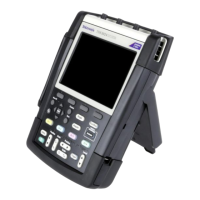Trigger Functions
Trigger Filter
Trigger filteri
ng determines what part of the signal is passed to the trigger circuit.
Edge triggering can u se both available filter types: Noise Reject and HF Reject.
Following are
some typical trigger applications:
Use the AutoRange™ function to have full automatic triggering and stable
display of m
ost waveforms.
If the signal is unstable or has a very low frequency, you can c ontrol the
trigger lev
el, slope, and trigger delay for a better view of the signal. (See
next section.)
For dedica
ted applications, use one of the three manual trigger functions:
Edge triggering
Video triggering
Pulse Width triggering
Choose a Trigger Type
You can select from the following trigger types:
Table 3: Trigger types
Trigger type Trigger conditions
Edge
Trigger on a rising, falling, or either rising or falling
edges, as defined by the slope control. Filter
choices are HF Reject and Noise Reject.
Edge triggers are the simplest and most commonly
used trigger type, with both analog and digital
signals. An edge trigger event occurs when the
trigger source passes through a specified voltage
level in the specified direction.
Pulse width Trigger on pulses that are less than, greater than,
equal to, or not equal to a specified time. You can
trigger on positive or negative pulses. Pulse width
triggers are primarily used on digital signals.
THS3000 Series Oscilloscopes User Manual 61

